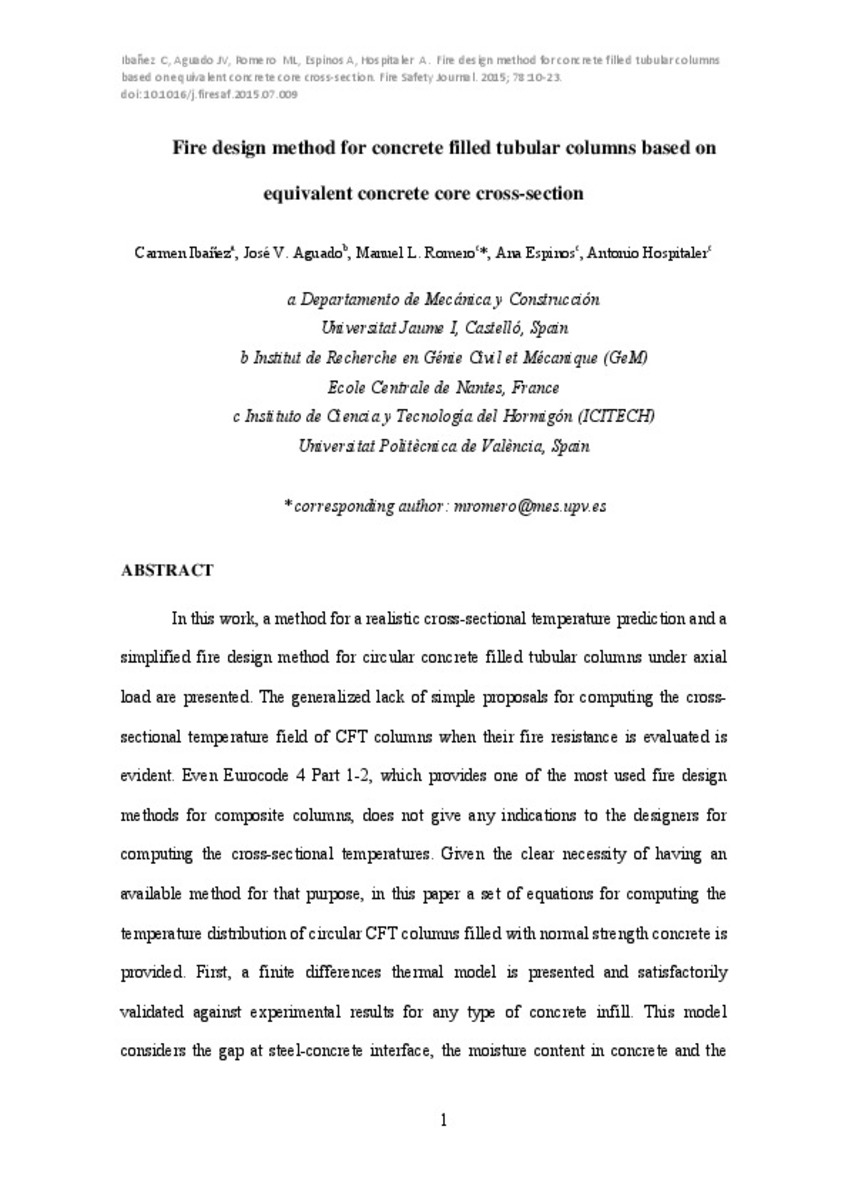Mostra el registre parcial de l'element
Fire design method for concrete filled tubular columns based on equivalent concrete core cross-section
| dc.contributor.author | Ibáñez Usach, Carmen | |
| dc.contributor.author | Aguado, José V. | |
| dc.contributor.author | Romero, M. L. | |
| dc.contributor.author | Espinós, Ana | |
| dc.contributor.author | Hospitaler, Antonio | |
| dc.date.accessioned | 2016-05-13T13:54:53Z | |
| dc.date.available | 2016-05-13T13:54:53Z | |
| dc.date.issued | 2015 | |
| dc.identifier.citation | IBAÑEZ, Carmen, et al. Fire design method for concrete filled tubular columns based on equivalent concrete core cross-section. Fire Safety Journal, 2015, vol. 78, p. 10-23. | ca_CA |
| dc.identifier.issn | 0379-7112 | |
| dc.identifier.issn | 1873-7226 | |
| dc.identifier.uri | http://hdl.handle.net/10234/159620 | |
| dc.description.abstract | In this work, a method for a realistic cross-sectional temperature prediction and a simplified fire design method for circular concrete filled tubular columns under axial load are presented. The generalized lack of simple proposals for computing the cross-sectional temperature field of CFT columns when their fire resistance is evaluated is evident. Even Eurocode 4 Part 1-2, which provides one of the most used fire design methods for composite columns, does not give any indications to the designers for computing the cross-sectional temperatures. Given the clear necessity of having an available method for that purpose, in this paper a set of equations for computing the temperature distribution of circular CFT columns filled with normal strength concrete is provided. First, a finite differences thermal model is presented and satisfactorily validated against experimental results for any type of concrete infill. This model consideres the gap at steel–concrete interface, the moisture content in concrete and the temperature dependent properties of both materials. Using this model, a thermal parametric analysis is executed and from the corresponding statistical analysis of the data generated, the practical expressions are derived. The second part of the paper deals with the development of a fire design method for axially loaded CFT columns based on the general rules stablished in Eurocode 4 Part 1-1 and employing the concept of room temperature equivalent concrete core cross-section. In order to propose simple equations, a multiple nonlinear regression analysis is made with the numerical results generated through a thermo-mechanical parametric analysis. Once more, predicted results are compared to experimental values giving a reasonable accuracy and slightly safe results. | ca_CA |
| dc.format.extent | 56 p. | ca_CA |
| dc.format.mimetype | application/pdf | ca_CA |
| dc.language.iso | eng | ca_CA |
| dc.publisher | Elsevier | ca_CA |
| dc.relation.isPartOf | Fire Safety Journal Volume 78, November 2015, Pages 10–23 | ca_CA |
| dc.rights | opyright © 2015 Elsevier Ltd. All rights reserved. | ca_CA |
| dc.rights | Attribution-NonCommercial-NoDerivs 4.0 Spain | * |
| dc.rights.uri | http://creativecommons.org/licenses/by-nc-nd/4.0/ | * |
| dc.subject | Concrete filled tubular column | ca_CA |
| dc.subject | Numerical model | ca_CA |
| dc.subject | Finite differences | ca_CA |
| dc.subject | Temperature prediction | ca_CA |
| dc.subject | Simple calculation procedure | ca_CA |
| dc.subject | Equivalent cross-section | ca_CA |
| dc.subject | Fire resistance | ca_CA |
| dc.subject | Eurocode 4 | ca_CA |
| dc.title | Fire design method for concrete filled tubular columns based on equivalent concrete core cross-section | ca_CA |
| dc.type | info:eu-repo/semantics/article | ca_CA |
| dc.identifier.doi | http://dx.doi.org/10.1016/j.firesaf.2015.07.009 | |
| dc.rights.accessRights | info:eu-repo/semantics/openAccess | ca_CA |
| dc.relation.publisherVersion | http://www.sciencedirect.com/science/article/pii/S0379711215300084 | ca_CA |
Fitxers en aquest element
Aquest element apareix en la col·lecció o col·leccions següent(s)
-
EMC_Articles [810]








